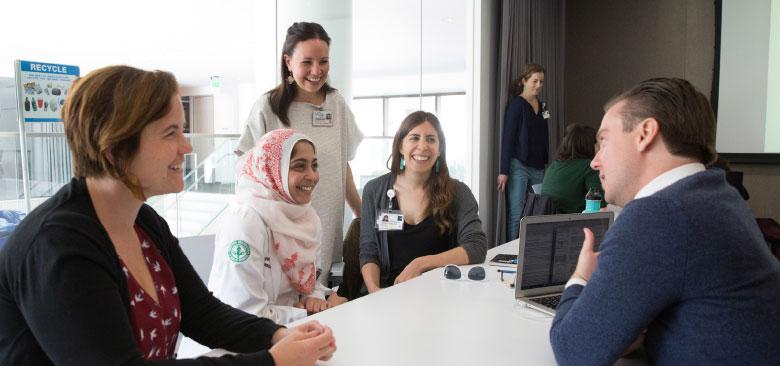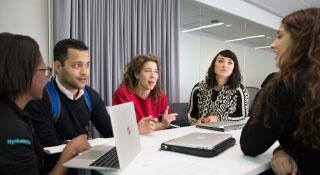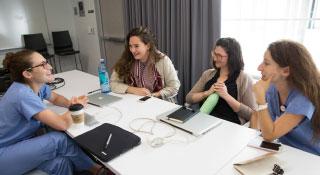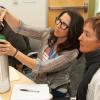
From left: Darcy Stanley, midwifery student; Meher Raza, visiting medical student; Kim Dau, certified nurse-midwife; Kathleen Reutter, midwifery student; David Klein, OB-GYN resident (photos by Elisabeth Fall)
Midwives and Obstetricians Train Together to Improve Care
This can be a tough time to be pregnant in the United States. Headlines bemoaning the high maternal mortality rate abound, accompanied by much hand-wringing over the current shortage of obstetricians (OBs) and the closure of maternity units in rural hospitals across the country, which may be contributing to the dismal statistics. Among the proposed solutions is better integrating midwives into the maternity care system, a proposition that will require breaking down silos that have divided midwifery and obstetrics in the U.S.
UC San Francisco aims to be part of the solution as one of four sites for a demonstration project that puts midwifery students and OB residents together during a critical part of their clinical training.
Separate Development Leads to Misunderstanding of Roles
 Certified nurse-midwives Kim Dau (standing, left) and Kate Frometa lead their class at UCSF’s Mission Bay campus. Almost alone among industrialized countries, the U.S. has relied on obstetricians to provide the bulk of its maternity care since the early part of the 20th century, with midwifery largely pushed aside until the last decade or so. Consequently, the two disciplines evolved separately, leading to a misunderstanding of each other’s roles and lack of trust that has, perhaps, hampered efforts to integrate these professions effectively.
Certified nurse-midwives Kim Dau (standing, left) and Kate Frometa lead their class at UCSF’s Mission Bay campus. Almost alone among industrialized countries, the U.S. has relied on obstetricians to provide the bulk of its maternity care since the early part of the 20th century, with midwifery largely pushed aside until the last decade or so. Consequently, the two disciplines evolved separately, leading to a misunderstanding of each other’s roles and lack of trust that has, perhaps, hampered efforts to integrate these professions effectively.
“This project brings [midwifery students and OB-GYN residents] together during an impressionable part of their learning, and part of our goal is to create a culture of respecting our interprofessional colleagues in both directions,” says Kim Dau, assistant clinical professor of Family Health Care Nursing at the UCSF School of Nursing and director of its Certified Nurse-Midwife/Women’s Health Nurse Practitioner program. Dau co-leads the interprofessional training project with Amy (Meg) Autry, residency director for UCSF’s Department of Obstetrics, Gynecology & Reproductive Sciences.
Now in its second year, the project is funded, in part, by the Josiah Macy Jr. Foundation and has the support of both the American College of Nurse-Midwives (ACNM) and the American College of Obstetricians and Gynecologists (ACOG), who have been working together to promote a more collaborative model of maternity care. It is also one of a number of interprofessional education initiatives at UCSF, and builds on UCSF’s long and unique history of collaboration between midwives and OBs, which some students see as a model for what collaborative practice and education could look like in the future.
Putting Midwifery Students and OB Residents Together at Mission Bay
In the UCSF project, midwifery students from the School join first-year OB-GYN residents in the classroom for didactic sessions. The cohort then spends a clinical rotation working together on antepartum and intrapartum units at UCSF Betty Irene Moore Women’s Hospital on the Mission Bay campus.
 From left: Natsai Nyakudarika, OB-GYN resident; Peter Movilla, OB-GYN resident; Michelle Levinson, midwifery student; Signy Toquinto, midwifery student; Noor Joudi, visiting medical student The didactics focus on discussions of roles, interprofessionalism, philosophies of care and communication, all the while inviting students to confront their own biases and misunderstandings. Dau, Autry and the project team use pre- and post-project surveys of participants and other measurement tools to evaluate how attitudes and understanding of roles have (or have not) improved as a result of the project.
From left: Natsai Nyakudarika, OB-GYN resident; Peter Movilla, OB-GYN resident; Michelle Levinson, midwifery student; Signy Toquinto, midwifery student; Noor Joudi, visiting medical student The didactics focus on discussions of roles, interprofessionalism, philosophies of care and communication, all the while inviting students to confront their own biases and misunderstandings. Dau, Autry and the project team use pre- and post-project surveys of participants and other measurement tools to evaluate how attitudes and understanding of roles have (or have not) improved as a result of the project.
“It was really valuable to talk about the assumptions we make in our various disciplines,” says midwifery student Signy Toquinto. “It was humbling to find out what it takes for [OB-GYN residents] to get where they are, and I think they were interested in the fact that many of us [midwifery students] already had master’s degrees or have been nurses for a long time. You don’t always get the opportunity to [have those conversations] in a clinical setting.”
Establishing trust and understanding is crucial for the clinical rotation, in which the students and residents are responsible for triaging and managing the same group of patients, under the direction of a midwife supervisor. That’s different from UCSF’s traditional training model at Priscilla Chan and Mark Zuckerberg San Francisco General Hospital and Trauma Center (ZSFG), in which midwifery students and OB-GYN trainees do their clinical rotations separately, within their own services, among colleagues from the same discipline.
Learning from One Another
In the demonstration project, the midwifery students not only learn technical skills from OB residents who have more education and experience under their belts when they begin their residency, but also glean an understanding of what it takes to work on a labor and delivery floor that must cope with patients of all complexities.
Both Toquinto and Genna Purcell, another midwifery student who completed the interprofessional rotation, were jolted by the pace required by a heavier patient load than they had experienced during their ZSFG rotations.
 From left: Rebecca Schwartz, OB-GYN resident; Bridget Rochios, midwifery student; Adi Vered Afek, midwifery student; Hannah Kohrman, medical student Purcell says, “There were a lot more things necessary to keep the system running. A lot of check-ins and a lot more protocol for how things went during labor.”
From left: Rebecca Schwartz, OB-GYN resident; Bridget Rochios, midwifery student; Adi Vered Afek, midwifery student; Hannah Kohrman, medical student Purcell says, “There were a lot more things necessary to keep the system running. A lot of check-ins and a lot more protocol for how things went during labor.”
Toquinto appreciated the experience of working with patients that she would not generally see in a midwifery-only rotation. “It was good to be exposed to patients who required more medical intervention. I learned things I wouldn’t necessarily have learned otherwise.”
She gives the example of a delivery she was managing as the primary provider with an OB-GYN resident as backup. Despite an uncomplicated birth, a problem developed with the delivery of the placenta. “When we realized that this was something I wasn’t able to [manage], I was so impressed with the way we flipped roles,” she says. “She was still teaching me, explaining what she was doing, even though it was out of my scope of practice.”
For her part, OB resident Diamond Goodwin says she benefited from watching midwifery students apply the model of care they learn in their training. “They have a unique skill set – helping mothers cope with labor, support for family – I call it ‘midwifery magic.’ It was good to see that in practice because I think most of us [OB-GYN residents] also aspire to practice that way and develop those tools and skills.”
That type of trust, interprofessional respect and open communication are essential components of quality collaborative care. Dau hopes that interprofessional training projects like this one, and those at the demonstration project’s sister sites (at the University of Minnesota, Drexel University/Frontier Nursing University and Baystate Health), will help increase integration of midwifery into the American maternity care system and create collaborative relationships that will improve care and increase access to those who need it most.
She says, “If residents have exposure to midwives when they’re training, they’ll better understand what the role of a midwife is and vice versa, and when they go out to practice, they are more likely to collaborate successfully.”
Purcell says, “It was amazing to see midwives practice in that environment and how aware the OBs [at UCSF] are of them. Some of the chiefs were telling me about how they did hand maneuvers, and they’d say, [midwife] ‘Judith Bishop taught me that.’”



